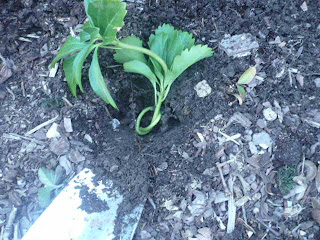Thank goodness for good neighbors (and we have lots of them!) One couple, Sally and Mark, aside from being great people are a wealth of knowledge in the garden. She's a landscape architect and he is a landscaper (sorry Mark-not sure of your exact title.) Basically, she designs the landscape, and he gets the plants in the ground and maintains them.
Several weeks ago, I emailed them and asked if I could have more pachysandra from their yard. Until two years ago, I was unaware that pachysandra existed or of its laudable qualities. Pachysandra is an ever-green ground cover much like ivy, but, as my neighbors tell me, it is better. It's lush and dense, yet soft. It does spread like crazy, but unlike ivy or Vinca, it is easy to pull up. It likes shade but can take sun. (Click here for more information on
pachysandra.) Being the kind people they are, they told me to come down at any point and clip some pachysandra. So my three-year-old son and I took his red wagon, a trash bag and some clippers--oh yeah, and a plastic lawnmower--to their yard and went to work--I on the pachysandra; he on the grass.
Their pachysandra is well-established, so thinning it a bit actually helps it, so I'm told. If you know someone with an established bed of pachysandra, you are in luck!
Here is how to transplant it. The great thing is that you don't need to get the plants' roots. Just snip off a long shoot and throw it in a bag. After bringing your bag home, tie the stems into knots like so:
Dip a small hole with your trowel and pop the knot in the hole. Cover it thoroughly and firmly, and you are done. Our neighbors even gave us some extra
Holly Tone to put on the plants.
After planting the pachysandra, I just scattered liberal portions of the fertilizer over the plants. It will rain tonight, so I don't even need to water the pachysandra.
I hope we'll have nice, lush bed of pachysandra in a few years!
Thank you Sally and Mark since you taught me everything I wrote in this post! And thanks for the plants and fertilizer too!
xo-
Carson















